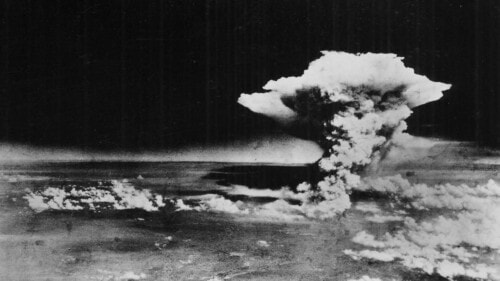- Home | Arts & Culture |
- Truman Library Makes Plans to Host Hiroshima Trees
Truman Library Makes Plans to Host Hiroshima Trees Living Legacy of Total War
Published April 4th, 2023 at 6:00 AM
Above image credit: Truman Library visitors to the exhibit can examine Katy McCormick’s photographs displayed alongside witness testimonials of the bombings. (Brian Burnes | Flatland)
Hiroshima trees may soon take root at the Truman Library.
Library visitors last week learned of the landscaping project, now being planned, while viewing photographs depicting the trees that survived the atomic bombings of Hiroshima and Nagasaki, ordered by President Harry Truman and hastening the end of World War II.
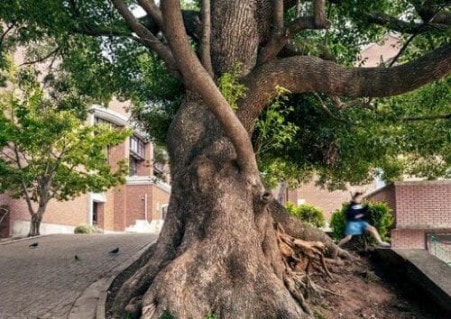
Living Legacy at Truman Library
Access to “Rooted among the Ashes: Hibakujumoku/A-bombed Trees,” is included with regular admission to the Harry S. Truman Presidential Library and Museum, 500 U.S. W. 24, in Independence. The exhibit runs through Oct. 1.
The exhibit, “Rooted among the Ashes: Hibakujumoku/A-bombed Trees,” features photographs by Kansas City native Katy McCormick.
The Japanese term hibakujumoku refers to trees that survived the blasts that flattened the two cities.
McCormick’s images document the trees, the sometimes twisted and contorted manner in which they have grown since 1945, how some since have been shored up and supported, and how many believe they represent a universal will to survive and endure.
“I care deeply about these trees,” McCormick said at the exhibit’s opening on Friday.
“I care deeply about what they represent — survival, life, hope. They show the care which they have been given in life, because the people around them cared for them and made sure they didn’t die.
“They did their best to keep them alive, whatever it took.”
The exhibit features large-format photographs, about 40-by-60 inches each, printed on bamboo paper and hung like scrolls. Their vivid colors contrast with the continuous loop of black-and-white newsreel footage and archival images captured after the bombings and presented as part of the exhibit installation.
“I had read many accounts of survivors who spoke about the significance of seeing green in the ruins,” McCormick said.
“They were so encouraged. Many of the trees were thought to be dead. But then they were coming back to life, and there were several people who wrote about the idea that — if these trees could survive — then they could survive.”
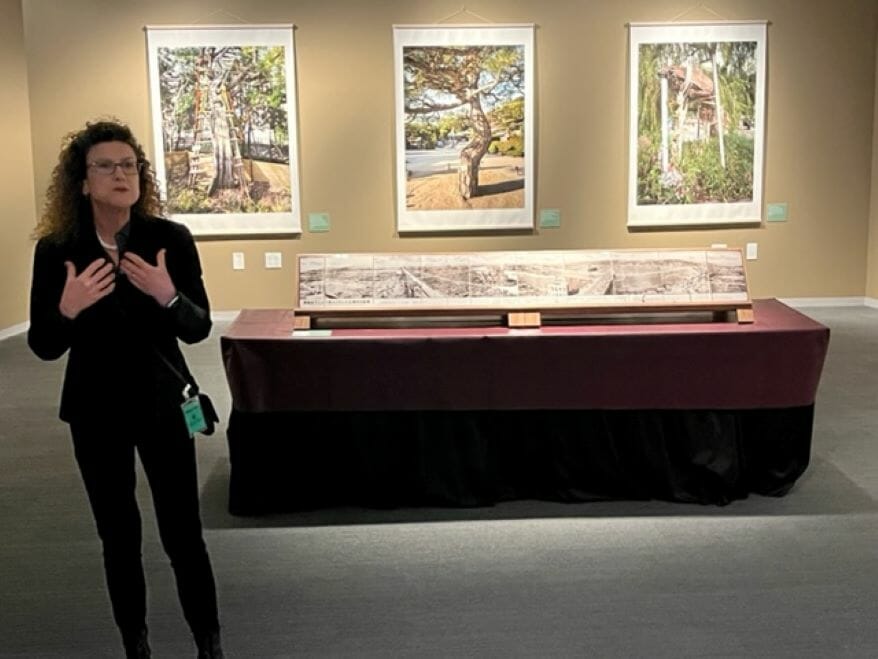
Trees Strange but Marvelous
McCormick first encountered the trees in 2008 when accompanying her husband to Japan to attend that year’s ceremonies observing the Hiroshima and Nagasaki bombing anniversaries.
“People from all over the world were there,” she said. “I felt such a mixture of sorrow, of mourning, of guilt, of hope.”
The trees that survived the blasts, meanwhile, represented to McCormick an unexpected discovery as she explored Hiroshima.
“While walking around I came upon this kind of crazy, twisted, amazing tree,” she said. “I saw a yellow tag and it read ‘A-Bombed Eucalyptus Tree, 740 meters from hypocenter.’”
A seismology term, “hypocenter” also refers to the point on the earth’s surface directly below a nuclear explosion. Both the Hiroshima and Nagasaki bombs detonated during their descent.
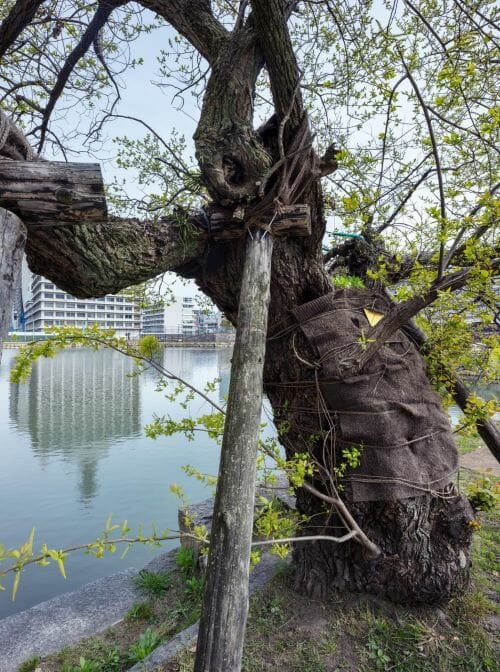
“I thought, ‘My God, this tree was here,’” McCormick said.
“Then I saw giant pussy willow – again, a crazy tree, very strange. But it was marvelous because there was so much vitality in it.
“Then I came upon a ginkgo tree, and then a pine.“
McCormick soon recognized the seed of a project. Today an associate professor of photography at the Creative School, Toronto Metropolitan University, McCormick returned to Japan in 2013, bringing with her a 4-by-5-inch field camera and tripod.
“I was a spectacle,” she said.
But her elaborate gear, as well as her visible level of focus, impressed the many Japanese who welcomed her to the locations of various trees, today maintained in or near elementary schools, shrines and other public spaces.
“Everyone opened their doors and welcomed me and allowed me to take photographs, and were so receptive — not only receptive but, dare I say, thankful — that I was interested in doing this work,” she said.
“They appreciated my care and attention to the landscape, and they seemed to understand that I was very committed to making photographs that I intended to share.”
No Blame or Anger
The welcome McCormick received mirrored that given Clifton Truman Daniel, the former president’s eldest grandson.
Since 2010 Daniel has been in a continuing public dialogue with survivors of the Hiroshima and Nagasaki bombings and their extended family members.
That year he met with Masahiro Sasaki, the older brother of Sadako Sasaki, a 2-year-old Hiroshima girl who survived the bombing but who years later was diagnosed with leukemia attributed to radiation exposure.
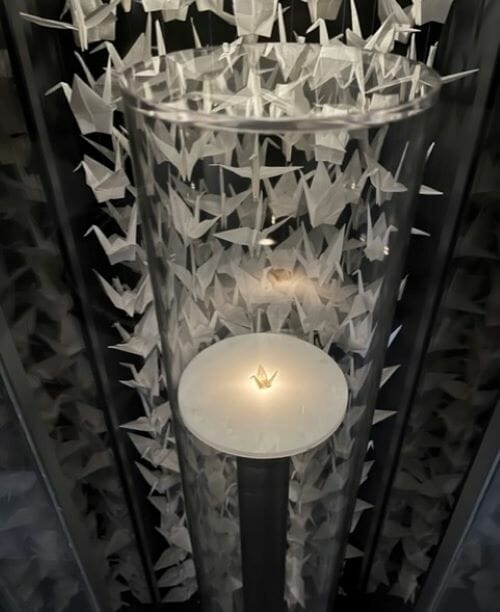
A subsequent book, “Sadako and the Thousand Paper Cranes,” detailed how she began folding hundreds of origami paper cranes, honoring a Japanese tradition that promised she would be granted a wish if she produced 1,000 of them.
Although she folded some 1,300 cranes, Sadako died in 1955 at age 12.
During his meeting with Masahiro, Daniel was presented with a tiny paper crane, identified as being one of the last Sadako had folded.
In 2012 Daniel became the first Truman family member to travel to Hiroshima and Nagasaki.
“The trees were part of that experience for me,” he said.
“Katy has captured almost exactly what I saw and felt while standing in front of those trees. And that there actually will be a tree or two from Hiroshima or Nagasaki on the grounds of the Truman Library, I think is appropriate.”
The 50th anniversary of the Hiroshima and Nagasaki bombings in 1995 prompted a sometimes contentious debate among scholars.
Some maintained President Truman made his decision at least in part to make unnecessary the traditional invasions of the Japanese home islands that would have resulted in horrific loss of life among the forces both attacking and defending Japan.
Others maintained Truman had other options.
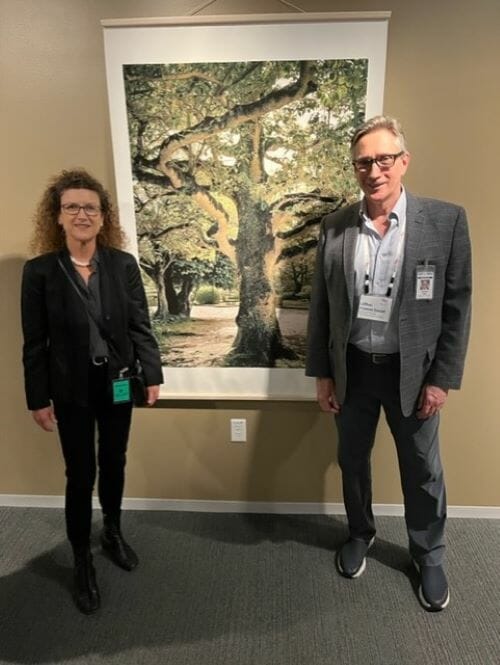
“No matter what side of the issue we are on,” Daniel said, “after it is over, we put that away and have empathy.
“There’s a quote from Franklin Roosevelt that a nation does not have to be cruel to be strong.”
Daniel returned to Japan in 2013, collecting testimony from Hiroshima or Nagasaki survivors.
“They never came to me with blame, anger, or any of that,” Daniel said of the survivors.
“They just said, ‘Tell the story’ and ‘Don’t ever do this again.’”
Today, the Truman Library displays the tiny origami paper crane Daniel first held in 2010. Five years later, Masahiro Sasaki presented it formally to Daniel during a library ceremony.
It is exhibited just across from a display of the safety plug from the bomb deployed over Nagasaki.
“We paired the trigger of the atomic age, if you will, with the symbol of peace that came out that horrific experience,” said Kurt Graham, Truman Library director.
Daniel also returned from his 2013 trip with tree saplings, with all the necessary paperwork to clear customs.
Survivor Tree Descendants
In 1912 the mayor of Tokyo sent 3,000 cherry blossom trees to Washington, D.C.
In 2012, to observe the centennial of that gift, Japan gave another 3,000 cherry blossom trees to the United States.
Of those, 14 young trees arrived in Kansas City, where the Kansas City Parks and Recreation Department took custody of them. They now stand in Loose Park, where they normally bloom by mid-April.
Trees long have been a symbol of peace and goodwill between the Japan and the United States.
The hibakujumoku seeds and saplings intended for the Truman Library, meanwhile, represent a more specific sentiment.

Powell Gardens, the botanical garden located some 30 miles east of Kansas City, in tandem with the Truman Library, is one of 24 United States partners listed by Green Legacy Hiroshima Initiative, a global volunteer campaign established in 2011.
In 2013 Powell Gardens representatives received a separate shipment of seeds from two species of trees — ginkgo and jujube.
“It is with emotion that we entrust to you these precious messengers of life and peace,” Nassrine Azimi, the initiative’s co-founder, wrote in an accompanying letter cited on the Powell Gardens website.
The ginkgo seeds came from a tree that survived the blast in Hiroshima’s Shukkeien Garden, which dates to the 17th century. The jujube seeds came from a tree that grows alongside Peace Boulevard, also in Hiroshima.
Ultimately, survivor tree descendants now at Powell Gardens will be incorporated into the landscaping project, now in the planning stages, for the library’s approximately 14-acre site, Graham said.
The project, Graham said, will feature a timeline of Truman Administration decisions or events that will include the end of World War II.
“I think it says a lot about Harry Truman and the attitude that the Japanese have had about him, and did from the beginning, during his lifetime,” Graham said.
“They understood that he was not a vindictive, angry, mean-spirited leader — that he had a war to end, that’s how he described it — and I think the people of Japan have largely accepted that,” Graham said.
“I don’t pretend to speak for anybody who went through that horrific event, and I’m not trying to minimize it in any way. I’m just simply saying that, to me, it feels very appropriate that the descendants of the trees that survived those bombs would be planted here at the Truman Library as — as Clifton said — a symbol of our hope that nothing like that ever happens again.”
Project design will continue in the coming months, Graham added, with the actual installation likely occurring in 2024.
Documenting the Nuclear Age
McCormick’s photographs, meanwhile, will be on display through Oct. 1.
The images represent a level of technical proficiency that may not be immediately obvious to visitors, said Claude Baillargeon, McCormick’s husband, who is an art history professor at Oakland University in Michigan.
McCormick worked with 4-by-5-inch film, resulting in negatives with sufficient resolution that allowed her to produce large prints with clarity, he said.
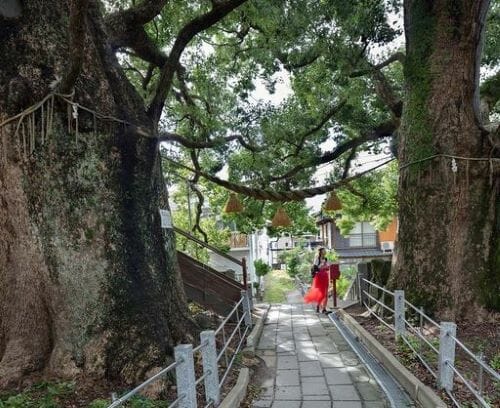
She also used a field camera outfitted with a tilt-shift lens that could be adjusted, allowing her to make three different exposures which she then, using computer software, stitched together to produce a single image, he added.
This process produced images that presented individual trees without the distortion of proportion that the use of a traditional camera might have resulted in, he said.
McCormick subsequently printed her completed images on bamboo paper and, finally, hung them without glass protection, eliminating any possible glare that gallery lighting might produce.
“We are so close to the trees, it’s palpable,” Baillargeon said.
“It’s not quite, but very close to, the experience you would have if you were right there.”
Those who linger in the installation soon will notice how accompanying videos of the survivor trees are exhibited with ambient audio.
They also will encounter text panels devoted to the testimonials of witnesses detailing the destruction, as well as the archival newsreel footage and photographs, playing on an exhibit monitor.
Three of the photographs shown there, McCormick said, were taken by Yoshito Matsushige, a Hiroshima news photographer who captured the only five images known to be taken on Aug. 6, 1945.
His images, McCormick added, surfaced following the suppression of post-bombing photographs and film footage enforced by American occupying forces.
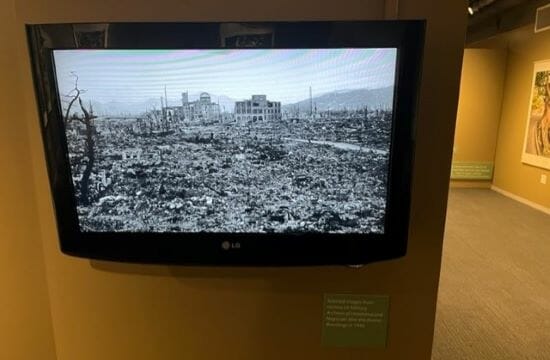
McCormick is a member of the Atomic Photographers Guild, a coalition of artists whose members document the nuclear age in all its manifestations.
Her guild colleagues, she said, “have a very strong interest to look critically at the histories and to raise awareness, but we are also all artists, so we are also trying to make compelling images that make people want to look at them, think about them, and then go a little bit deeper.”
McCormick returned to Japan several times following her first visit in 2008, most recently in 2019.
“Today I have this great love of Japan, for both the people and these trees, because these extraordinary living memorials sort of spoke to me over the course of many years.”
While all the trees have been well cared for, some of them nevertheless are showing varying degrees of fatigue, McCormick added.
“I don’t know how long some of these trees will be around. So, rush to Hiroshima and Nagasaki and see these trees while you still can.
“And, if you can’t do that, spend some time with this show, and I think they will speak to you.”
Flatland contributor Brian Burnes is a Kansas City area writer and author.
More on Flatland
A Tale of Atomic Bombs and Paper Cranes For the past decade, President Harry Truman’s eldest grandson has engaged in a continuing public dialogue with survivors of the atomic bombs dropped on Hiroshima and Nagasaki 75 years ago.
Tags: Harry S. Truman Presidential Library & Museum • Harry Truman • Hiroshima • History • Truman Library
Like what you are reading?
Discover more unheard stories about Kansas City, every Thursday.
Thank you for subscribing!
Check your inbox, you should see something from us.
Ready to read next



